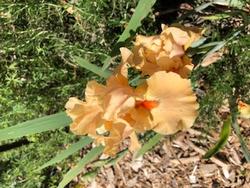Water Wise Plants
Bearded Iris
Pronunciation
Common Name
Bearded Iris
Plant Type
Bulb
Mature Size
1.5 to 4 feet high Spreads via rhizomes
Water Requirements
Low: water every three weeks until the root ball is wet
Sun/Shade Requirements
Full to half sun
Wildlife
Flower Color
Many colors except true red and green,
Maintenance- Design- Planting Tips
Bearded irises are beloved for their showy spring flowers, structurally pleasing upright, green leaves and low, summer water needs. They come in a wide range of colors and shapes. Choosing a mix of early, mid and late bloomers prolongs the spring bloom period, and the addition of re-blooming varieties gives another flush of flowers in the fall and winter season. Unfortunately, re-blooming varieties do need water year-round to re-bloom, and the second bloom has fewer flowers. All bearded irises need full sun for at least half the day to bloom well.
Given enough water from late fall through spring, intermediate bearded iris can grow to a height of 2.5 feet tall, and tall bearded iris can reach 4 feet in height. With enough water they develop tall flower stalks supporting numerous large blooms. With less water during the growing season, the plants are smaller with fewer flowers, but the blooms are still striking. Improve growth by adding compost and mulch in the fall, which helps retain soil moisture and provides nutrients for better bloom. Allow plant leaves and soil to dry out between watering to prevent fungal infections and flower loss. During the summer, bearded irises are dormant, and their leaves die back. For aesthetics many people cut the leaves back when they begin to yellow, but it is not necessary. Plants remain healthy with and without summer trims. Be aware though, there is one major maintenance issue when growing bearded iris. These plants grow from thick rhizomes. Each year new rhizomes spread from the original making a larger clump. As the older rhizomes die, a dead spot will eventually appear in the center of the iris clump. To prevent this from happening and to keep clump size in check, divide iris rhizomes about every three years. Do this during the hot summer months when plants are dormant and fungal infections are less likely to affect the cuts from the mother rhizomes.
Where to See
|







